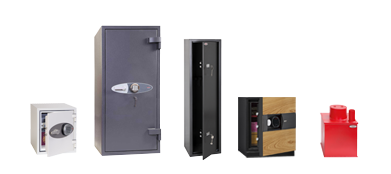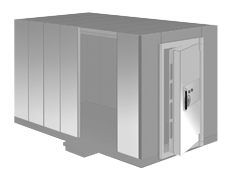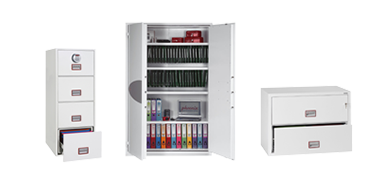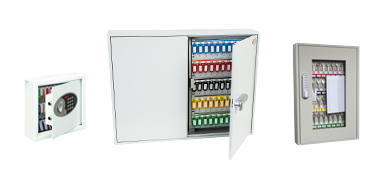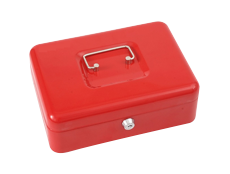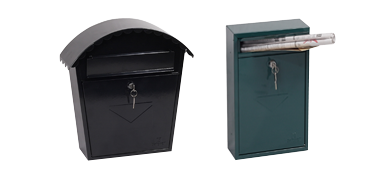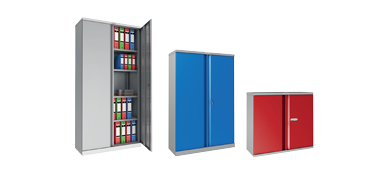What is a data safe?
Data safes are used to securely store tapes, hard drives, USB sticks, CDs, DVDs, film stock and other forms electronic data.
Fire data safes have a fire rating which reflects the lower temperature at which data can be corrupted or the media melted and destroyed. The inside of the safe needs to be below the temperature at which they will combust. Full details of the fire standards which Phoenix data safes conform to are given below.
Fire rating for data safes
The fire rating of a safe describes the level of fire resistance. There are three parts to the fire rating test:
- Explosion hazard test – simulates a safe being suddenly subjected to extremely high temperatures.
- Fire endurance test – exposes a safe to high temperatures over a period of time.
- Fire drop test – replicates the effect of a safe falling through a burning building.
Fire paper safes are suitable for storing important paper documents such as birth certificates, wills, house deeds, contracts, business documents.
Fire data safes require greater protection than paper as the media can melt or become corrupted at a lower temperature.
The fire test standards below require that the critical maximum temperature of the following media cannot be exceeded:
- Paper: 175˚C
- Digital media: 120˚
- Computer data: 52˚C
Phoenix use a range of standards, including the NT Fire test specifications which originate from the European NordTest standards
NT Fire 017-60 Paper – Requires safe to be heated to 945°c for 1 hour. The maximum temperature inside the cabinet shall not exceed 175°c.
NT Fire 017-90 Paper – Requires safe to be heated to 1050°c for 90 minutes. The maximum temperature inside the cabinet shall not exceed 175°c.
NT Fire 017-120 Dis (for data) – Requires safe to be heated to 1090°c for 2 hours. The maximum temperature inside the cabinet shall not exceed 52°c.
NT Fire 017-120 Paper – Requires safe to be heated to 1090°c for 2 hours. The maximum temperature inside the cabinet shall not exceed 175°c.
The EN 1047 Fire Test is another European standard which Phoenix uses, specifically the EN1047-120 Dis for data. This requires safes to be heated to over 1100˚C for 2 Hours. Internal temperatures shall not exceed 52˚C.
LPS 30P, LPS 60P – EN 15659 – Light Fire Resistance where the internal Temperature will not exceed 175˚C.
GB16810-1997 – Requires the safe to be heated to 945˚C for 1 hour. The Maximum temperature inside the cabinet shall not exceed 175˚C.
MTS DIP 120-60DM (Grade B) – Digital Media fire protection where The internal temperature will not exceed 120˚C.
What is a data combi safe?
A data combi safe is a fire safe for paper which contains a compartment with additional insulation for storing data items. For example, the Phoenix Datacombi DS2501K is a fire safe for paper, with a compartment for data and a cash rating of £2,500 or £25,000 for valuables.
Can I get fire safe inserts for safes?
Yes, Phoenix produce fireproof inserts to keep data safe from fire within a security safe. For example, we have the Phoenix FSDP103.
What do you want protection from?
Burglary protection and fire protection are the two main reasons for buying a safe.
While all safes offer a degree of burglary protection, there are a range of options available. A quick way to determine the level of security is the insurance rating.
The right data safe for you is one which provides the appropriate level of security, access, features and space.
When choosing a data safe you will need to answer the following questions:
-
- What do you want to secure?
- What do you want protection from? (Usually burglary and fire).
<li”>What level of security will I need? This is relevant to your insurance cover.
- What type of access will I require? Eg. key lock or key pad.
- How much storage space will I require inside the safe?
- Where will I locate my safe and can it be installed there.
Type of lock
All our locks provide an excellent level of security. The type of lock you choose should depend on what suits your needs. The types of lock available are:
- Key lock – The traditional method with no danger of batteries running out. The risks are in losing the keys and in ensuring the keys themselves are kept in a safe place. We can supply replacement keys for most Phoenix models, though be sure to check if replacement keys would be available for your model. To obtain replacement keys we would require proof of purchase in the form of a copy invoice, delivery note or details of your registered guarantee as well as the key number.
- Electronic keypad – A pin code is entered to open the safe. You can change the pin code as often as you like. A low battery warning lets you know when to replace the batteries. The risks are in forgetting the code.
- Fingerprint – Phoenix safes use biometric security in the form of a fingerprint which is initially scanned in during set-up and confirmed. To open the safe, press the finger against the scanner and open the safe door. The Phoenix fingerprint lock can store up to 128 different fingerprints. Fingerprint locks also require batteries and a low battery warning lets you know when to replace the batteries.
- Dual lock – This is where two key codes are required to open the safe. On a Phoenix safe, the user will type in the first code and press Open, then type in the second code and press Open. This can be useful when you wish to have two people required to open a safe. The two people can have a code each.
- Changeable lock – A changeable lock is one which can replaced if required without damaging the safe. If a lock becomes damaged or compromised, it can be replaced without the cost and inconvenience of replacing the whole safe.
Size of data safe
Due to the thickness of the doors and walls, safes are smaller on the inside than they appear on the outside. This is particularly true of fireproof safes where fire-resistant materials are used in the casing. Always check the internal measurements of a safe are adequate for your needs.
Given the relatively small size of hard drives and USB sticks, data safes are often smaller than conventional safes. However it’s often worth getting a safe with more storage area than you currently require as you may wish to store more items in the future.
Where to locate your data safe
Firstly, do you require a floor safe or a wall safe? Make sure you have enough room to open the door and access the safe.
Data safes often require regular access. Consequently, hiding a wall safe or underfloor safe behind or beneath heavy furniture may not be suitable.
Installing a safe
Make sure you can install the safe – large safes will be heavy and difficult to move. Ensure they can get through doorways and up or down any stairs. Heavy safes may need to be moved professionally. Many suppliers offer installation services and it can be worth investigating these when purchasing a large safe.
A poorly installed safe that is easily removed could invalidate the insurance. Check your safe is installed correctly in order to satisfy the insurance rating. Check with our instructions and your insurer. Sometimes an insurer will require the safe to be installed by a qualified professional.
To comply with testing procedures, safes which are EN14450 or EN1143 certified and weigh less than one tonne should be fixed to a solid floor. Rear fixing is used for additional security. Using rear fixing alone, or attaching to a wooden floor may invalidate the insurance and this should be checked.
Solid surfaces such as concrete or brick are preferable for fixing the safe. A safe should be installed flush against a surface. Any carpet should be removed from the floor and skirting board removed if the safe is to be secured against a wall while sitting on the floor.
Security safes will include pre-drilled holes for the bolts to be attached through. Remember that only selected fireproof safes can be bolted to the floor as it can compromise the fire protection.
When installing a safe yourself, you will need a good drill with a masonry drill bit. Follow the supplied instructions for marking where to drill holes and fitting the bolts to anchor your safe to the floor or wall.
Data safe extras
Back up keys – Essential if you forget or lose the entry the code for a keypad lock. Back up keys will also be required when batteries fail on locks where the batteries can only be changed from inside the safe.
Alarm – The alarm is set when closing the door. In a Phoenix safe the alarm will sound if the safe is tilted over 45 degrees or impacted.
Internal light – An internal light can be particularly useful for safes which are stored in dark locations.
Water resistant – Whilst guarding against fire, it can also be important to protect against sprinkler systems and fire hoses which may be used to put out any fire. Guarding against flooding can also be a consideration for ground level and underfloor safes.
Shelves – Adjustable and removable shelving can help organise your data safe and maximise the number of items you can store in an organised fashion.
Soft lining – Carpet, felt or another material can be used to line the safe providing protection against scratches.
Drawers and inserts – Particularly in larger safes, drawers can be useful for organising the contents. Lockable drawers provide extra security. For example, staff may have access to the safe, while a manager may have access to the lockable drawer. Inserts are often used for storing data items.
If you require any further information to help choose a data safe, please contact us here and we will be glad to help.


 USA
USA ES
ES DE
DE FR
FR